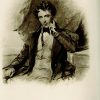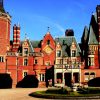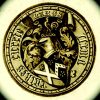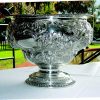Raikes Currie is best described as a wealthy, urbane Anglican savant who remained professionally unfulfilled in his father’s banking house, prompting him to turn to liberal politics.
In the Reform Parliament of the mid-1830s he won and held the popular vote in the seat of Northampton for twenty years. He was well read, moved in polite intellectual circles and became a confidant of John Stuart Mill, Sir William Molesworth, Charles Buller, and George and Harriet Grote, all of whom were better known as core members of the Philosophical Radicals. They were the sparkling faction which, when aligned with the Whigs in the House of Commons, carried the South Australia Act 1834, despite strident opposition from the Tories.
Philosophically and temperamentally, Currie was in tune with utilitarian and Benthamite thinking on colonisation. He became a member of several related organisations including the Provisional Committee of the South Australian Association in December 1833, the South Australian Church Society in January 1834 and the South Australian Literary and Scientific Association, which formed after the Bill was passed in August 1834.
As a director of Curries & Co. banking house he was instrumental in procuring substantial monies as surety for the colonisation project. He never hesitated to help where he could and responded enthusiastically, graciously and generously to all requests from the South Australian Colonization Commission. These are the reasons why he is memorialised in the streets of Adelaide. Both he and Pascoe St Leger Grenfell were paired and nominated by the Street Naming Committee because of their financial patronage and their dedication to the religious and theoretical principles embodied in the plan.
Currie was Treasurer of the Anglican-driven Society for the Propagation of the Gospel in Foreign Parts, which counted the Archdeacon of New South Wales as President, Captain John Hindmarsh as Vice President, and other of the Philosophical Radicals as members.
Raikes Currie, the second son of Isaac and Mary Anne Currie (nee Raikes), was born 15 April 1801 at his father’s estate of Bush Hill, in Middlesex. Raikes’ grandfather, William Currie, moved to London in the mid-eighteenth century where he set up a malt distillery in Limehouse, presumably taking inspiration from the distaff side of his family, the Shaw Lefevres, who had been distillers for some time. The Shaw Lefevres are the same family memorialised in North Adelaide.
In the latter half of the eighteenth century both families coalesced in business and their distillery was successful. They also invested in the banking house they established at No. 29 Cornhill Street, just a few doors from Lloyd’s of London. This led to the genesis of a succession of profitable banks: Currie, Lefevre, James & Yallowly, established in 1781; Curries & Co.; and Glyn Mills and Co. – all past constituents of today’s Royal Bank of Scotland.
Classically educated at Eton, Raikes Currie joined Curries & Co. in 1822. However, after reading John Locke’s An essay concerning human understanding (published in 1689) at the tender age of 18 he developed a passion for philosophy and metaphysics.
Through his studies he inevitably found his way to Jeremy Bentham and the utilitarian movement, and from there it was but a small leap to philosophical radicalism. He married the Hon Sophia Laura Wodehouse, daughter of the second Lord Wodehouse, on 28 June 1825. Together they had six children – four boys and two girls.
Once the South Australian Colonization Commission was established in mid-1835 there remained the question of selling sufficient preliminary land orders for the South Australia project to proceed. Four banking houses, Currie’s among them, agreed to receive monies from intending colonists. Currie, along with Pascoe St Leger Grenfell, was also enlisted to loan £10,000 as surety in the event that any of the intending colonists defaulted. At the point of departure for South Australia when there were virtually no defaulters, they graciously waived the interest.
Raikes Currie and Pascoe St Leger Grenfell were also vitally interested in how the diversity of religious expression might play out in the colony. They were keen to see the Anglican Church established there. Currie gave generously towards the appointment of the Reverend C.B. Howard, and promised an annual donation of £50 to the Church Society, should it in turn manage to raise £150 annually.
It was Currie who suggested that the South Australian Company should branch into banking, which it eventually did, despite an initial conflict of interest. Later, when the colony fell on hard times, tenders were called for financial help to assist it from its possible demise. The London Assurance Company was the only institution to show interest. When it was clear the colony could not be run by generating its own resources, the South Australian Colonization Commission was disbanded and the Crown took closer control. Currie’s influence remained and he became a member of the newly formed South Australian Society (in 1840) and of the House of Commons Committee of Inquiry into the affairs of the colony.
When he joined the parliament in 1837, Raikes Currie was opposed to the Corn Laws, the Game Laws and Church Tithes in both Ireland and England. He fought for the expulsion of the bishops from the House of Lords, Catholic emancipation in Ireland and the Poor Laws in wider Britain. On these and other points he consequently came under fire in the Tory press, especially The Times.
Other parliamentary measures which Currie supported at various times included the abolition of punishment by death (in 1846), universal education and church reform. Unlike some politicians he also took his beliefs into the wider community. He was a strong supporter of Mechanics’ Institutes and singlehandedly funded a school for eighty or so pupils.
His work with Rowland Hill on the South Australian Colonization Commission, where Hill was Secretary, probably explains his participation in the House of Commons Committee of Inquiry into postage costs, which led to the greatest postal reforms ever in Britain.
When at parliament, Raikes Currie joined both the Reform and Athenaeum clubs of Pall Mall. At the Reform Club he mingled with contemporaries and friends like George Warde Norman (Governor of the Bank of England), Buller and especially Molesworth, who was described in the 1850s as his closest acquaintance. Currie’s closest friends, however, throughout most of his time in parliament were the Grotes and their coterie of Philosophical Radicals.
Outside parliament Currie had a rich and fruitful life. Besides the obvious connections with the South Australian Company and its subsidiary activities in banking, which he and George Fife Angas initiated, Currie had further commercial interests and directorships. He also sought investment opportunity in the Americas, purchasing the patent for an improved wheat grinding and milling machine from the designer Mr George Bovill.
After his father’s death in 1843, Raikes Currie assumed total proprietary ownership of Curries & Co. It continued to grow strongly, especially under the influence of his two elder sons George and Bertram, and finally amalgamated with Glyns of Lombard Street to become Glyn, Mills, Currie & Co. in 1864.
Currie was a patron of the Royal Agricultural Society and a member of The Royal Society. In his time he served as magistrate for both Buckinghamshire and Essex and became the magistrate and Deputy Lieutenant for Middlesex. In Northampton he usually chaired the local branch of the Whig/radical party.
He withdrew to private retirement, preferring to be with his growing family. In 1860 he purchased the impressive estate of Minley Manor and spent the better part of the last twenty years of his life there.
In 1869 Raikes’ wife Sophia died, ending a 44-year marriage. He now clung to immediate family, preferring to spend the winters in the house next to his son Bertram in Hill Street. He also remained close to Lord Wodehouse, his wife’s father.
The last connection the Currie family had with South Australia was in 1881, the year Raikes died peacefully at Minley Manor. It was the year his grandson, John Currie, became the Head of the Chamber of Commerce in Adelaide.
Raikes Currie lived life to the full. He left an estate worth £280,000, which included property, investments, some exquisite furniture, fine antiquarian books and beautiful paintings.








Comments